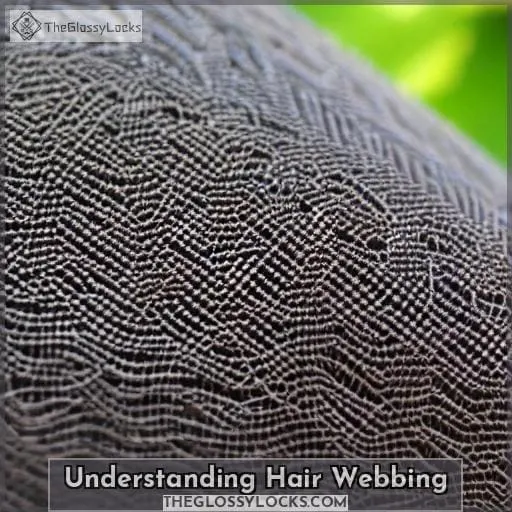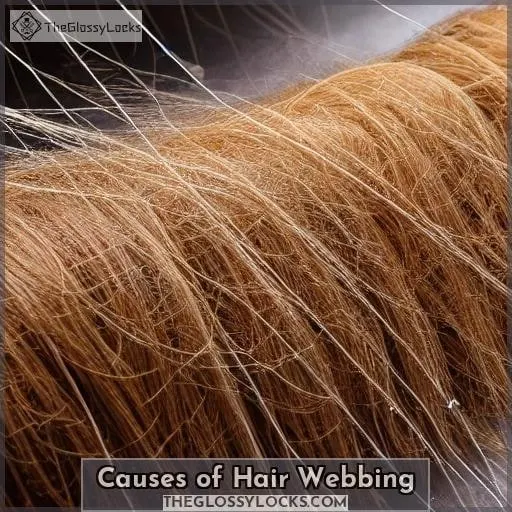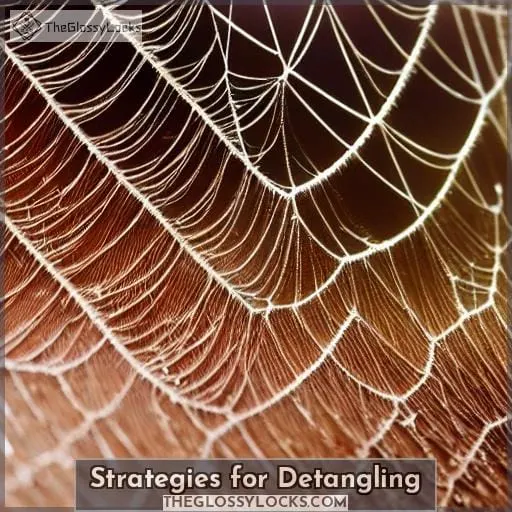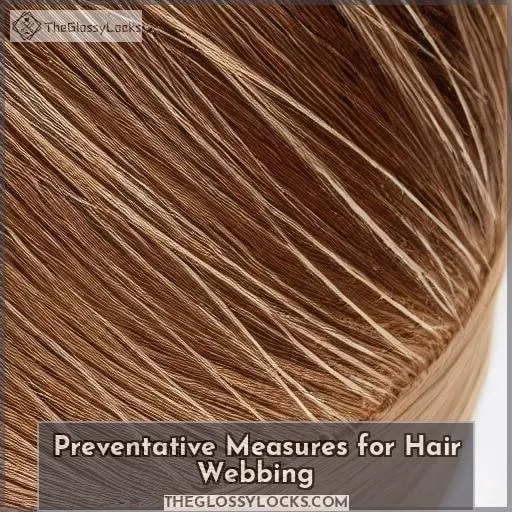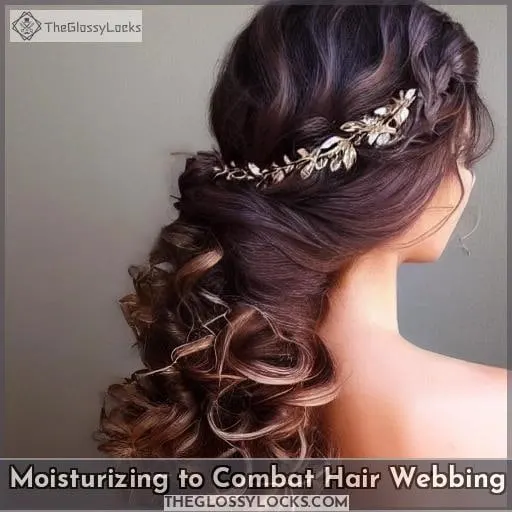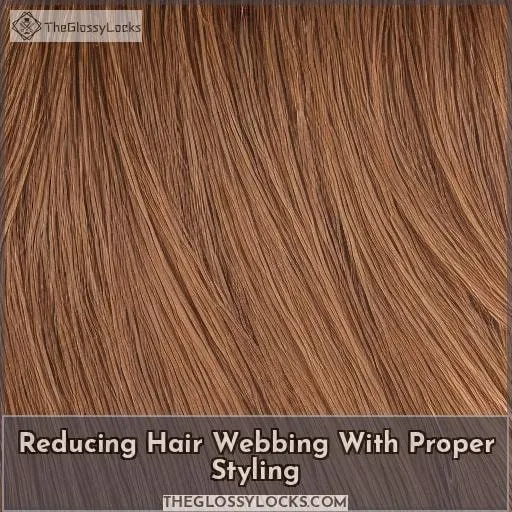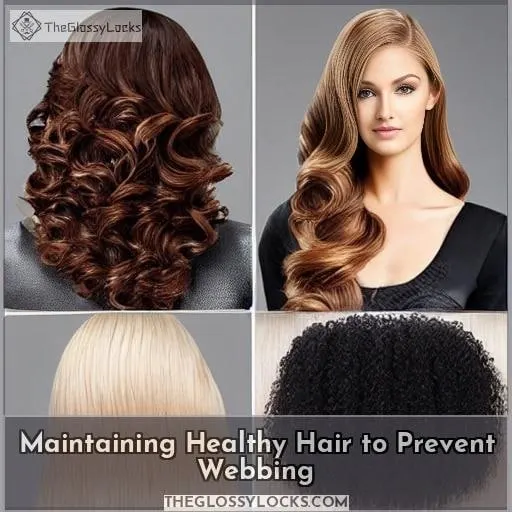This site is supported by our readers. We may earn a commission, at no cost to you, if you purchase through links.
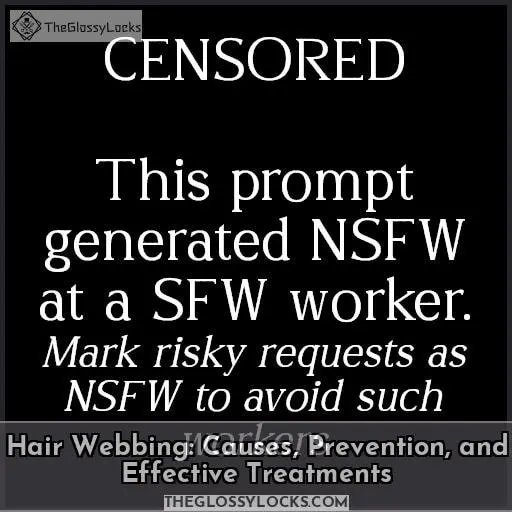 Ironically, the very thing that makes your hair unique could be weaving a tangled tale of distress. You’re not alone if you’ve noticed your strands sticking together, forming a frustrating, web-like mess.
Ironically, the very thing that makes your hair unique could be weaving a tangled tale of distress. You’re not alone if you’ve noticed your strands sticking together, forming a frustrating, web-like mess.
This phenomenon, known as hair webbing, is more than just a bad hair day—it’s a cry for help from your locks. Whether it’s the aftermath of a shower or the result of a styling session gone wrong, understanding the causes, prevention, and effective treatments for hair webbing can transform your hair care routine, granting you the freedom and control you’ve been yearning for.
Let’s unravel the mystery together and restore your hair’s health and beauty.
Table Of Contents
- Key Takeaways
- Understanding Hair Webbing
- Causes of Hair Webbing
- Strategies for Detangling
- Preventative Measures for Hair Webbing
- Moisturizing to Combat Hair Webbing
- Reducing Hair Webbing With Proper Styling
- Maintaining Healthy Hair to Prevent Webbing
- Frequently Asked Questions (FAQs)
- Can hair webbing affect all hair types or only curly hair?
- How does the weather or climate impact hair webbing?
- Are there specific hair products that exacerbate hair webbing?
- Can dietary changes help reduce the occurrence of hair webbing?
- How does hair length influence the likelihood of experiencing hair webbing?
- Conclusion
Key Takeaways
- Hair webbing is a condition where hair strands tangle and stick together, often resembling a spider web, and is more common in curly hair due to its dryness and susceptibility to damage.
- The primary cause of hair webbing is a lack of moisture, which leads to flattened hair cuticles and strands sticking together. Other contributing factors include chemical and heat damage, as well as physical manipulation leading to tangles and matting.
- To detangle hair that is webbing, it is recommended to use moisturizing treatments, start detangling from the ends, and use gentle separation techniques with the help of products.
- Preventative measures for hair webbing include regular washing and conditioning to maintain hydration, using protective hairstyles, trimming split ends, avoiding heat styling, and consistently moisturizing with heavy oils and protein treatments.
Understanding Hair Webbing
Hair webbing is a condition where hair strands become entangled, resembling a spider web, primarily due to insufficient moisture leading to cuticle flattening and hair attachment. This issue is more prevalent in individuals with curly hair, as their hair type is naturally drier and more susceptible to damage.
Factors contributing to hair webbing include heat styling, chemical damage, product buildup, and hair tangles. To manage hair webbing, it’s essential to adopt practices that restore moisture and rebuild the hair’s molecular layer.
Some effective strategies include using deep conditioning treatments, regularly deep cleaning the hair to remove product buildup, limiting heat styling, trimming hair regularly to remove tangles and split ends, and employing protective hairstyles to reduce breakage and lock in moisture.
Definition
Hair webbing is like your strands throwing a tangled party without your permission. Imagine each hair as a social butterfly, sticking to its neighbors and creating a complex network that resembles a spider’s web.
This pesky issue is a cry for hydration, as dryness causes your hair cuticles to rise and mingle too closely, leading to those annoying tangles. If you’ve got curly or fine hair, you might find yourself battling hair webbing more often, thanks to your hair’s texture and porosity making it more prone to dryness and breakage.
But don’t fret; with the right care, you can keep your locks from turning into a hair horror show. Regular deep conditioning, avoiding harsh chemicals and heat, and embracing protective styles can help maintain your hair’s moisture balance and prevent those strands from sticking together like unwanted glue.
Symptoms
Hair webbing, a condition that can leave your locks looking like a tangled mess, is more than just a bad hair day waiting to happen. It’s a cry for help from your tresses, signaling a need for a change in your hair care routine.
If you’ve ever found yourself staring in the mirror, puzzled by the chaotic web of hair strands, you’re not alone.
- Your hair’s got more tangles than a mystery novel. Every strand seems to weave its own intricate plot, making detangling a Herculean task.
- Roughness and dryness have become the norm. Your hair feels more like a bristle brush than the silky mane you dream of.
- Split ends are throwing a party, and every hair strand is invited. It’s like your hair is trying to socialize by splitting up into groups.
- Moisture absorption has left the chat. Despite your best efforts, your hair seems to repel moisture like it’s got a personal vendetta against hydration.
Causes of Hair Webbing
Hair webbing is a condition where your strands become entangled, resembling a spider web, and it’s often a precursor to more severe hair issues like breakage or matting. This frustrating phenomenon is primarily due to dehydration and dryness, which cause the hair cuticles to flatten and stick together.
Additionally, chemical and heat damage can exacerbate the problem, as these factors further weaken the hair’s structure and moisture balance.
When you style your hair with heat tools or undergo chemical treatments, you’re putting your strands at risk. These processes can strip away moisture and protective barriers, leaving your hair vulnerable to tangling and webbing.
Moreover, the physical manipulation of hair, such as brushing or styling, can also contribute to the formation of tangles and eventually lead to webbing if not managed properly.
To keep your hair free from webbing, it’s crucial to maintain proper hydration and minimize damage from styling practices. Regular deep conditioning treatments can help restore moisture, while protective hairstyles and trimming split ends can prevent further tangling and damage.
Remember, your hair’s health is a reflection of how you care for it, so treat it gently and keep it nourished to avoid the pitfalls of hair webbing.
Dehydration and Dryness
Hair webbing is a condition where hair strands become entangled and flattened, resembling a spider web. This issue is primarily caused by a lack of moisture, leading to the flattening of the hair cuticle and strands sticking together.
It’s more common in curly hair due to its natural dryness and susceptibility to damage. Factors contributing to hair webbing include heat styling, chemical damage, product buildup, and hair tangles.
To manage hair webbing, it’s essential to use deep conditioning treatments to restore moisture, regularly deep clean hair to remove product buildup, limit heat styling, trim hair regularly to remove tangles and split ends, and use protective hairstyles to reduce breakage and lock in moisture.
Chemical and Heat Damage
Continuing from the woes of dehydration and dryness, let’s dive into the havoc chemical and heat damage wreak on your tresses.
These culprits can alter your hair’s texture and increase porosity, making your locks more prone to that dreaded bed head look. If you’re a fan of heat styling or chemical treatments, you might notice your hair becoming stringy or forming those pesky webs.
But fear not! A little protective care goes a long way. Swap out harsh hair products for gentler ones, and maybe give those flat irons a rest.
Tangles and Matting
Continuing from the woes of chemical and heat damage, let’s untangle the mess that’s hair webbing. You see, when your hair gets tangled and matted, it’s like a garden overrun with weeds. It’s not just an eyesore; it’s a sign that your hair is crying out for help. Tangled hair and matted hair are the unruly culprits leading to hair breakage and stunted hair growth.
But don’t fret, there’s a silver lining. With a bit of elbow grease and the right techniques, you can smooth things over. Think of detangling as a peace treaty between your strands. By incorporating protective hairstyles, you’re essentially giving your hair a shield against the chaos of knots.
And remember, regular hair trimming is like pruning a tree—it encourages growth and keeps the wildness at bay.
So, let’s roll up our sleeves and show those tangles who’s boss. With deep cleaning and a dash of humor, we’ll turn that bird’s nest into a sleek masterpiece. After all, every strand is a story, and yours deserves a fairy-tale ending, not a horror plot twist.
Strategies for Detangling
When tackling hair webbing, it’s crucial to approach detangling with care and the right methods.
Moisturizing treatments and specific detangling techniques can help ease the process, ensuring your hair remains healthy and manageable.
Moisturizing Treatments
To keep your hair from turning into a tangled web, you’ll want to embrace moisturizing treatments that quench your locks’ thirst.
- Deep Conditioning Treatment: This is your hair’s tall glass of water. Slather on a hair mask rich in natural humectants like honey or aloe vera to draw in moisture.
- Sealant Selection: After the deep condition, don’t let that moisture escape! Seal it in with heavier oils like shea or castor oil to lock in the hydration.
- Regular Moisturizing Routines: Keep the moisture party going by regularly using leave-in conditioners and hair masks to maintain that silky smoothness.
Detangling Techniques
After quenching your hair’s thirst with moisturizing treatments, it’s time to tackle those tangles without causing a stir in your strands. Detangling doesn’t have to be a hair-raising experience. With the right approach, you can smooth things over and keep breakage at bay.
Here’s a quick guide to detangling that won’t leave you tangled up in frustration.
| Method | Tool | Frequency |
|---|---|---|
| Start at the ends | Wide-tooth comb or detangling brush | As needed, to prevent mats |
| Gentle separation | Fingers | Daily, for minimal stress |
| Product assistance | Leave-in conditioner or detangler | During wash days and as needed |
Preventative Measures for Hair Webbing
To keep hair webbing at bay, it’s crucial to adopt a proactive hair care routine.
Regular washing and conditioning, along with protective styling and timely trims, can significantly reduce your chances of encountering this issue.
Regular Washing and Conditioning
Hair webbing is a condition where hair strands become entangled, resembling a spider web, primarily due to insufficient moisture. This issue is more prevalent in curly hair, which is naturally drier and more prone to damage.
The main causes include dehydration, chemical and heat damage, and tangles leading to matting. To prevent hair webbing, it’s crucial to maintain a consistent moisturizing routine, utilizing conditioning products that restore and lock in moisture.
Regular washing and conditioning play a pivotal role in preventing this condition by ensuring both hair and scalp hydration. Adjusting washing frequency according to your hair’s needs helps maintain its health and prevent tangling and matting.
By incorporating these practices, you can significantly reduce the occurrence of hair webbing, making your hair easier to manage and style.
Protective Hairstyles
Continuing from the importance of regular washing and conditioning, let’s dive into the world of protective hairstyles. These styles are your hair’s best friends, acting as a shield against the elements and daily wear and tear.
- Braid Out: Unleash your hair’s potential with a braid out, giving you defined waves without the stress.
- Twist Out: Twist and shout! This style keeps your ends safe and gives you a fabulous look.
- Bun: The classic bun, a no-fuss fortress for your follicles.
- Pineapple: Keep it high and tight at night with a pineapple to prevent tangles and breakage.
Trimming Split Ends
Hair webbing, a condition where hair strands become entangled and resemble a spider web, is a common issue, especially for those with curly hair. This tangled mess is primarily due to a lack of moisture, leading to the flattening of cuticles and strands sticking together.
Factors like heat styling, chemical damage, product buildup, and natural hair tangles exacerbate the situation. The symptoms include hair that looks messy and feels rough and dry, making strands difficult to separate.
Preventing hair webbing involves a holistic approach to hair care. Deep conditioning treatments are crucial for restoring moisture and rebuilding the hair’s molecular layer. Regular deep cleaning helps remove product buildup, while limiting heat styling prevents further damage and dryness.
Regular trims are also essential to remove tangles and split ends, contributing to overall hair health. Protective hairstyles can help reduce breakage and lock in moisture, further preventing webbing.
For those dealing with hair webbing, detangling involves using moisturizing treatments and specific techniques like using aloe vera, Hawaiian silk activator, and detangling in twists. Moisturizing strategies include consistent hydration, using heavy oils like shea and castor oil, and applying protein treatments and rice water.
Proper styling, such as avoiding smaller twists that lead to more webbing and opting for flat twists or braids, can also reduce webbing.
In summary, managing hair webbing requires a comprehensive care routine focusing on moisture, protection, and regular maintenance. By addressing the root causes and employing effective prevention and treatment strategies, individuals can maintain healthy, tangle-free hair.
Moisturizing to Combat Hair Webbing
To effectively combat hair webbing, it’s essential to integrate deep conditioning into your hair care routine. This process replenishes moisture, which is crucial for keeping your hair strands from tangling and sticking together.
Additionally, employing the moisturize and seal method can help maintain hydration levels in your hair, preventing the dryness that often leads to webbing.
Deep Conditioning
To seamlessly transition from discussing preventative measures to the crucial role of deep conditioning in combating hair webbing, let’s dive into why this step is a game-changer.
Imagine your hair as a thirsty plant; just as the plant craves water, your locks yearn for moisture. Deep conditioning acts like a long, refreshing drink for your hair, targeting the core issues of dryness and brittleness that lead to webbing.
This process not only quenches your hair’s thirst but also strengthens the strands, repairs the cuticle, and promotes a healthy scalp.
By incorporating deep conditioning into your routine, you’re not just moisturizing; you’re building a fortress around each strand, making it resilient against the tangles and knots of webbing. So, let’s not skimp on this step; your hair will thank you with its silky, tangle-free presence.
Moisturize and Seal Method
Hair webbing is a condition where hair strands become entangled, resembling a spider web, primarily due to insufficient moisture. This issue is more prevalent in curly hair, which is naturally drier and more prone to damage.
The main causes include dehydration, chemical and heat damage, and tangles leading to matting. To manage hair webbing, it’s crucial to adopt a comprehensive hair care routine focusing on hydration, gentle handling, and protective styling.
To effectively combat hair webbing, the Moisturize and Seal Method is a cornerstone technique. This method focuses on locking in moisture to prevent the hair strands from becoming dry and tangled.
- Deep Conditioning: Regular deep conditioning treatments are essential. They replenish moisture and help repair damaged hair cuticles, making strands less prone to webbing.
- Hydration Techniques: Incorporate hydration techniques into your routine, such as using hair masks and oil blends that nourish and moisturize the hair deeply.
- Protective Styles: Opt for protective styles like twists or braids to minimize manipulation and reduce the chances of webbing. These styles also help retain moisture longer.
- Regular Trimming: Trimming split ends regularly can prevent tangles and knots, reducing the risk of hair webbing.
By following these steps, you can maintain well-moisturized hair, reducing the incidence of hair webbing and promoting healthier, more manageable locks.
Reducing Hair Webbing With Proper Styling
To reduce hair webbing, it’s essential to handle your hair gently and avoid heat styling whenever possible.
Embracing these practices can help maintain your hair’s integrity and prevent the tangling and matting that leads to webbing.
Avoiding Heat Styling
Avoiding heat styling is a smart move to keep your hair from getting tangled into a web-like mess. Think of your hair as a delicate fabric that can’t handle too much heat. Just like you wouldn’t blast your favorite silk blouse with a hot iron, you shouldn’t scorch your locks with high-temperature tools.
Instead, embrace your hair’s natural texture with products that love your locks as much as you do.
| Do | Don’t | Try |
|---|---|---|
| Use natural oils to moisturize | Crank up the heat on styling tools | Curl creams for texture |
| Apply leave-in conditioners for softness | Overuse hot tools, they’re not your hair’s BFF | Detangling products to avoid knots |
| Opt for scalp treatments for health | Forget heat protectants, they’re like sunscreen for your hair | Natural oils for a glossy finish |
Gentle Hair Handling
To keep your hair from turning into a tangled web, you’ve got to handle it with kid gloves.
- Detangle Gently: Use detangling techniques that are kind to your hair. Think of detangling as a delicate dance with your locks, where rough moves are a big no-no.
- Moisturize Like It’s Your Job: Moisturizing treatments are your hair’s best friend. Imagine them as a soothing balm that keeps the peace among your strands.
- Protect Your Hair: Embrace protective hairstyles that shield your hair from the chaos of daily life. It’s like giving your hair a cozy blanket to snuggle in.
- Trim Those Ends: Regular split end trimming is like housekeeping for your hair; it keeps everything tidy and prevents future messes.
Maintaining Healthy Hair to Prevent Webbing
To maintain healthy hair and prevent webbing, it’s essential to establish a regular hair care routine that includes using lightweight products.
These steps help ensure your hair stays hydrated, manageable, and free from the tangles that lead to webbing.
Regular Hair Care Routine
Maintaining a regular hair care routine is like nurturing a garden; you’ve got to tend to it with love and the right tools. Let’s talk about keeping your mane in tip-top shape. First off, hair brushing isn’t just about going through the motions; it’s an art form.
Think of your scalp as the soil that needs to be healthy for the strands to flourish. And just like you wouldn’t water plants with soda, picking the right product selection for your hair type is crucial.
Now, don’t forget your diet—feeding your hair from the inside out with nutrients is like giving your plants the best fertilizer. Lastly, stress management is the scarecrow that keeps the trouble-making crows at bay, ensuring your hair’s environment is just right for growth.
Here’s a quick cheat sheet to keep you on track:
| Hair Care Aspect | Why It’s Important | How to Maintain |
|---|---|---|
| Hair Brushing | Stimulates scalp and distributes oils | Gentle strokes, start from the ends |
| Product Selection | Matches products to hair needs | Choose based on hair type and issues |
| Scalp Health | Foundation for healthy hair | Regular cleansing and massages |
| Diet | Provides nutrients for growth | Balanced intake of vitamins and proteins |
Using Lightweight Products
Hair webbing is a condition that can make managing your locks feel like you’re untangling a spider’s web. But fear not! The key to preventing this tangled mess lies in the products you use. Opting for lightweight products is like choosing the right armor in the battle against hair webbing.
- Lightweight products keep your hair buoyant: Heavy products can weigh down your hair, exacerbating webbing. Lightweight options, on the other hand, help maintain volume and prevent strands from sticking together.
- They promote scalp health: A healthy scalp is the foundation of healthy hair. Products free from harsh chemicals nurture your scalp, avoiding irritation that can lead to hair damage and webbing.
- Proper brushing techniques are easier to apply: With lighter products, your hair isn’t weighed down, making it easier to implement gentle brushing techniques that reduce breakage and tangling.
Frequently Asked Questions (FAQs)
Can hair webbing affect all hair types or only curly hair?
Hair webbing can indeed affect all hair types, though it’s more common in curly hair due to its structure and dryness.
Don’t fret, straight-haired friends can join the tangle tango too; it’s an equal-opportunity annoyer.
How does the weather or climate impact hair webbing?
Weather and climate play a big role in hair webbing. Humid air can make your hair frizzier or curlier, causing strands to tangle and web, especially if you’ve got curls to begin with.
Cold, dry air, on the other hand, sucks the moisture right out, leaving your hair dry and prone to tangling. So, whether you’re battling a frizz fest in the tropics or fighting the freeze in the winter, keeping your hair moisturized is your secret weapon against the webbing woes.
Are there specific hair products that exacerbate hair webbing?
Yes, certain hair products can indeed make hair webbing worse. Products that are heavy or build up easily, like those containing silicones, waxes, and heavy oils, can contribute to the strands sticking together and forming that dreaded web-like tangle.
It’s like trying to solve a puzzle with pieces that just won’t fit; these products might seem like they’re helping by adding moisture or shine, but they’re actually just complicating the tangle.
So, if you’re battling hair webbing, it might be time to lighten up on the product front and choose options that hydrate without the heavyweight championship belt.
Can dietary changes help reduce the occurrence of hair webbing?
You’re in luck! Eating a balanced diet can be a game-changer for your hair, turning it from a tangled web into a luscious mane.
Think of it as fuel for your follicles.
How does hair length influence the likelihood of experiencing hair webbing?
Longer hair might seem like a dream, but it’s a double-edged sword when it comes to webbing.
The longer your locks, the more they tangle and twist, especially if they’re fine or chemically treated.
Shorter styles, on the flip side, tend to keep tangles at bay, making webbing less of a worry.
So, if you’re battling webbing, a trim might just be your secret weapon.
Conclusion
Unraveling the knots of hair webbing, you’ve discovered that the secret to silky, uncluttered locks lies in a blend of hydration, gentle handling, and regular maintenance.
Embrace these habits, and watch as hair webbing becomes a distant memory, leaving you with hair that’s as free and vibrant as you are.

